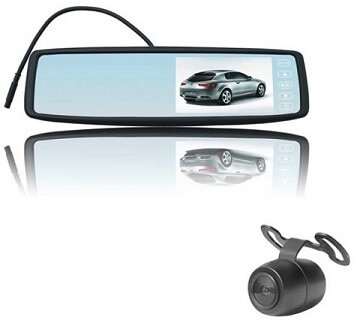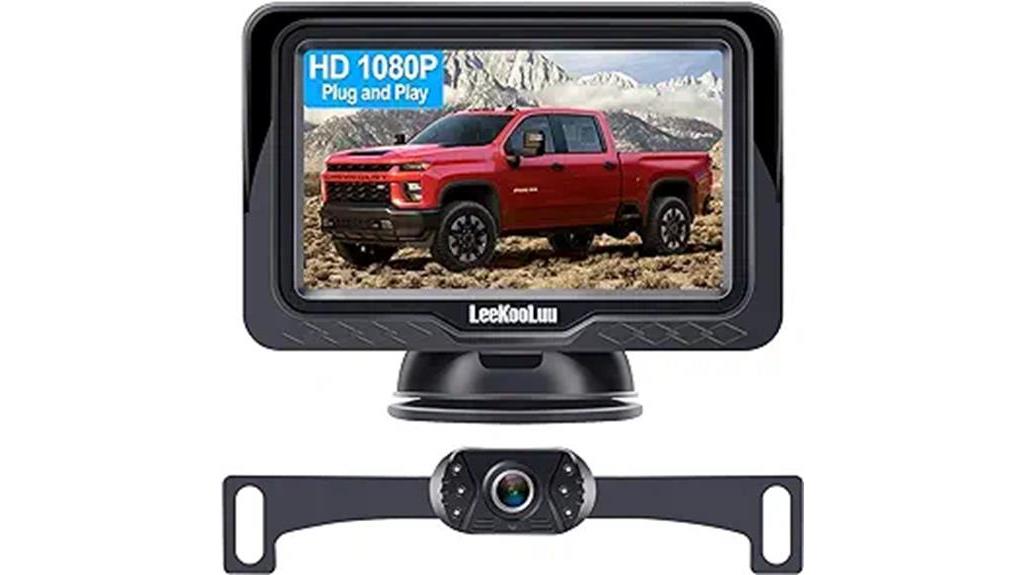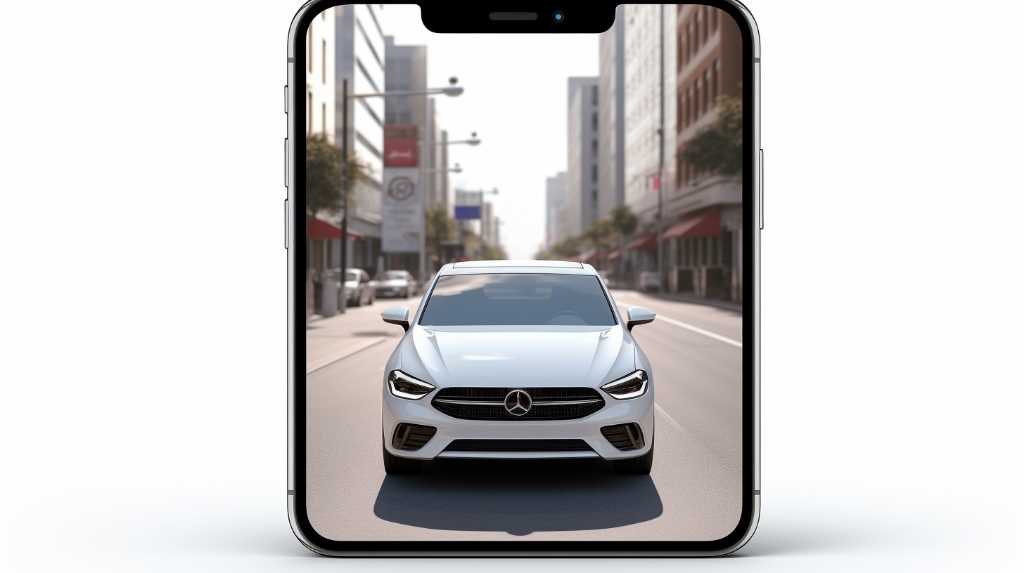Imagine you’re reversing in a crowded parking lot; the backup camera on your vehicle becomes your eyes for everything you can’t see directly behind you. Understanding the field of view that your camera provides is crucial for safe maneuvering. It’s the width of the area you can see on your screen at any given moment. Different cameras offer varying degrees of visibility, and it’s essential to know how lens angles impact what you see. You’ll want to learn about the types of cameras available, how to optimally install them, and the importance of calibration for maximum safety. By enhancing your visibility with the right backup camera features and maintaining it properly, you’ll make reversing not just easier, but safer too. Let’s dive into the details and help you see the whole picture.
Key Takeaways
- The field of view of a backup camera ranges from 90 degrees to 180 degrees.
- Optimal viewing angles for backup cameras typically range from 120 to 130 degrees.
- Wide-angle lenses provide a more comprehensive view and reduce blind spots.
- Wide-angle lenses can distort the image but help spot obstacles, pedestrians, and small children that standard lenses might miss.
Defining Field of View
While you’re reversing your vehicle, the field of view is the width and depth of the area your backup camera captures. It’s what you can see on your display screen, showing you what’s behind your car. This is crucial because it determines how well you can spot obstacles, pets, or even children that might be out of your direct line of sight.
Your car’s backup camera field of view typically ranges from about 90 degrees to a wide 180 degrees. The wider the angle, the more you’ll see behind you, but there’s a trade-off. With a wider field of view, objects can appear smaller and further away than they really are. This can be tricky when you’re trying to judge distances.
You’ve got to be aware that the field of view isn’t just about the horizontal stretch. It also involves the vertical range, which lets you see from the ground up to the skyline behind your car. The blend of horizontal and vertical coverage ensures you’ve got a comprehensive view of what’s happening behind you, helping you reverse safely.
Lens Angle Importance
You need to understand why the lens angle of your backup camera is critical. It’s a balance between capturing a wide view and managing the distortion that comes with it. Let’s explore how a wider angle can benefit you, weigh distortion against coverage, and determine the optimal viewing angles for your needs.
Wide Angle Benefits
In choosing a backup camera, the lens angle is crucial as it determines how much of the area behind your vehicle you’ll be able to see. Opt for a wide-angle lens, and you’ll enjoy some significant benefits. Firstly, you’ll get a more comprehensive view, significantly reducing blind spots. This means you can spot obstacles, pedestrians, or even small children that standard lenses might miss.
Moreover, a wide-angle lens simplifies parking in tight spaces. You’re not just seeing directly behind you; you’re getting a broader perspective that encompasses more of the periphery. This can make parallel parking or reversing into a spot much less stressful.
Distortion Vs. Coverage
As you compare backup camera options, it’s essential to weigh the trade-off between lens distortion and field of view coverage. A wider-angle lens gives you a more expansive view, ensuring you miss fewer obstacles behind you. However, this comes with a caveat: wide-angle lenses can distort the image, making objects appear further away than they actually are.
It’s crucial to find a balance. Look for a camera that provides sufficient coverage while maintaining image integrity. A moderate wide-angle lens, typically around 120 to 130 degrees, often strikes this balance, offering a broad view with minimal distortion. Remember, the lens angle is a pivotal factor in your backup camera’s performance, impacting both safety and ease of use. Choose wisely to ensure a clear and accurate perspective.
Optimal Viewing Angles
Selecting the right lens angle, typically between 120 and 130 degrees, ensures you’ll have a comprehensive yet clear view when reversing your vehicle. This sweet spot allows you to see enough of your surroundings to avoid obstacles without the fish-eye effect that wider angles can cause. Too narrow an angle might give you a sharp image, but you’ll miss potential hazards just outside your field of view.
Think of your backup camera’s lens angle like peripheral vision. You don’t need to see everything behind you to a 180-degree extent, but you do need enough coverage to react safely to your environment. That’s why the optimal viewing angle is crucial. It’s about balancing breadth of vision with visual accuracy, so you can reverse confidently and safely.
Camera Types and Angles
While you’re deciding on a backup camera for your vehicle, it’s crucial to understand that the camera type directly influences its field of view and the angles it can capture. There are two primary types: the wide-angle and the fisheye lens cameras.
Wide-angle cameras offer a broad view, usually around 100 to 200 degrees. This means you’ll catch more of what’s behind you, but there’s a trade-off. As the angle widens, objects may appear smaller and farther away than they actually are. It’s a great choice if you’re looking for general awareness of your surroundings.
On the other hand, fisheye lens cameras provide an even wider perspective, sometimes up to 180 degrees or more. They’re designed to give you an expansive view, but they can distort the image, especially at the edges. It’s like looking through a peephole – you see a lot, but shapes and distances aren’t true to life.
Your choice depends on what you value more: a realistic depiction or a wider scope. Remember, a camera with adjustable angles offers flexibility, allowing you to tweak the view to your preference. Always weigh the camera’s type against your specific needs to find the perfect balance for your driving experience.
Optimal Installation Strategies
When you’re installing a backup camera, the angle at which you mount it can make or break its effectiveness. You’ll need to follow vehicle-specific guidelines to ensure you’re getting the best view without blind spots. Additionally, proper wiring and connectivity are crucial to maintain a reliable feed from your camera to your display.
Camera Mounting Angles
Although you might not think about it, the angle at which your backup camera is mounted critically determines the effectiveness of its field of view. To ensure you’re capturing the best possible view, you’ll want to aim for an optimal angle that takes into account both the horizontal and vertical perspectives.
Typically, a downward tilt of about 30 to 45 degrees is recommended. This allows you to see the ground immediately behind your vehicle as well as the horizon. Horizontally, centering the camera gives a balanced view, avoiding blind spots. Remember, the goal is to mimic the natural line-of-sight you’d have if looking back.
When installing, use guides or a level to achieve this angle accurately. A misaligned camera won’t give you the full safety benefits it’s designed for.

Vehicle-Specific Guidelines
Since every vehicle’s design is unique, you’ll need to tailor your backup camera’s installation to fit your specific car or truck’s dimensions and shape. Consult your vehicle’s manual for any manufacturer recommendations on camera placement. Generally, you want to mount the camera high enough to get a broad perspective, yet low enough to spot immediate obstacles.
For trucks, consider the height of your tailgate when installing. Sedans often have a sweet spot above the license plate. Don’t overlook the horizontal angle; ensure your camera isn’t skewed to one side. Check the camera view for potential blind spots caused by the vehicle’s design, like spoilers or tail lights, and adjust accordingly. Remember, the goal is a clear, wide view without distortion or significant obstructions.
Wiring and Connectivity
Properly routing your backup camera’s wiring is crucial to maintain the integrity of the field of view and ensure a reliable connection. You’ll want to avoid any areas that can crimp or damage the cables, such as sharp edges or moving parts like the trunk hinge. It’s often best to run the wires along existing wiring harnesses, securing them with zip ties. This not only protects the wires but also keeps your installation tidy and professional-looking.
When connecting the camera, make sure the connectors are firmly seated and, if possible, use weatherproof connections to prevent moisture from causing issues. Remember, a solid connection is key to a clear and consistent camera feed, helping you reverse safely every time.
Calibration for Safety
To ensure your safety on the road, you’ll need to calibrate your backup camera’s field of view to account for blind spots and the vehicle’s dimensions. Since each car has a unique size and shape, the camera’s default settings might not be ideal for your situation.
Start by parking in an open area and placing markers at the corners of your vehicle’s rear end. Then, adjust the camera angle until these markers are visible on the screen. This helps you gauge the true extent of your car’s rear profile and ensures that you’re not missing any critical areas that could hide potential hazards.
Next, consider the distance scale lines that are often superimposed on the backup camera’s image. You’ll want to ensure these lines accurately represent the space behind your vehicle. Some systems allow you to adjust the scale line settings for more precise guidance when backing up.
Visibility Enhancement Features
Why should you consider visibility enhancement features when evaluating your backup camera’s field of view? These features can drastically improve your ability to see behind your vehicle, making reversing safer and more confident. You’re not just looking for the widest angle; you want the clearest picture possible, especially in low-light conditions or inclement weather.
Many backup cameras come with night vision capabilities, which are essential when you’re parking in dark areas. They use infrared lights to illuminate the space behind your car, giving you a clear image despite the lack of ambient light. You’ll also find cameras with built-in dynamic guidelines that adjust as you steer, showing you the path your vehicle is taking. This feature can help you navigate tight spots without second-guessing your trajectory.
Additional visibility enhancement may include high-definition video output, which offers sharper images compared to standard definition. This clarity can be the difference between spotting a small obstacle and missing it entirely. Some systems even integrate sensors that provide audible alerts if you’re getting too close to an object, complementing the visual information you get from the camera.

Backup Camera Maintenance
After exploring the importance of visibility enhancement features in your backup camera’s field of view, it’s crucial you maintain your camera’s functionality to ensure it continues providing clear and accurate visuals. Dirt, debris, and even weather conditions can obscure your camera’s lens, significantly reducing its effectiveness.
To keep your backup camera in top shape, regularly clean the lens with a soft, microfiber cloth. Be gentle to avoid scratches that can permanently impair the view. If you’re dealing with stubborn grime, use a mild, non-abrasive cleaner that’s safe for camera lenses. Steer clear of harsh chemicals that might damage the lens coating.
Don’t forget to check the camera’s housing and wiring. Ensure the seals are tight to prevent moisture from getting in and causing fog or electrical issues. In colder climates, ice can form on the lens; a dedicated camera heater or simply running your defrost can help prevent this.
Lastly, stay up to date with software updates if your camera system includes digital enhancements or overlays. These updates can fix bugs and improve the camera’s functionality.
Frequently Asked Questions
How Does Weather Affect the Backup Camera’s Field of View, and What Measures Can Be Taken to Mitigate These Effects?
Weather can blur or obstruct your backup camera’s view. To mitigate this, regularly clean the lens, install a protective cover, and consider cameras with built-in heaters or water-resistant features.
Can the Field of View of a Backup Camera Be Adjusted After Installation, and if So, What Are the Limitations?
You can often adjust your backup camera’s field of view after installation, but you’re limited by the camera’s design and the maximum angle it’s built to cover. Check your manual for specifics.
How Does the Field of View Interact With Vehicle Sensors and Parking Assist Systems to Improve Safety During Reversing?
You’ll find that your car’s field of view from the backup camera works with sensors and parking assists to spot obstacles, making reversing safer by giving you a fuller picture of what’s behind you.
Are There Any Legal Regulations or Standards That Dictate the Minimum Field of View Requirements for Backup Cameras in Vehicles?
Yes, you’ll find legal regulations, like the U.S. requirement for a 10-foot by 20-foot zone visible to drivers, ensuring a standard minimum field of view for all new vehicle backup cameras.
How Does the Addition of Towing Equipment, Like Trailers or Bike Racks, Impact the Effectiveness of the Backup Camera’s Field of View, and What Solutions Exist for These Scenarios?
When you add towing gear, it narrows your backup camera’s view, but attaching an auxiliary camera to the equipment can help maintain a clear perspective while reversing.
Conclusion
Now you’ve got the lowdown on backup camera fields of view. Remember, the lens angle matters, so choose the right camera type for your needs. Install it strategically to maximize visibility. Calibrate it to ensure safety, and don’t overlook features that enhance visibility. Keep it well-maintained and you’ll nail reversing every time. Trust your tech, but keep your eyes peeled, too. Safe driving!
Related Articles
Be sure to also check out these articles right here at Motion Performance Motorsports
The Complete Buyers Guide for Backup Cameras
Next Backup Camera Article: Top 5 Aftermarket Backup Cameras for Your Van
Previous backup Camera Article: Enhancing Safety: Night Vision Backup Camera Guide

Hey there, I’m Terra Frank, the driving force behind Motion Performance Motor Sports. I’m thrilled to have you here, exploring the fascinating world of cars, trucks, and everything related to automotive performance and accessories.




